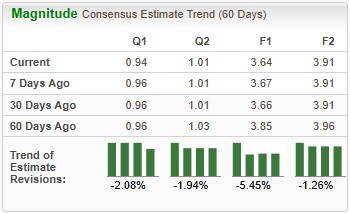|
|
|

|
|||||

|
|
Novo Nordisk NVO is a dominant player in the cardiometabolic space, marketing its blockbuster semaglutide-based (GLP-1) drugs — Ozempic (for type II diabetes [T2D]) and Wegovy (for obesity). These therapies are NVO’s key growth drivers, generating DKK 152.5 billion in the first nine months of 2025, including DKK 51.1 billion in the third quarter. Despite year-over-year growth of 9% and 23%, respectively, sales momentum for both drugs has slowed in recent quarters.
Weaker-than-expected sales of Ozempic and Wegovy contributed to Novo Nordisk’s disappointing third-quarter results, with both earnings and revenues missing estimates amid intensifying competition from Eli Lilly LLY and widespread compounded semaglutide use in the United States — factors that also drove its July guidance cut. Following third-quarter results, Novo Nordisk further trimmed its 2025 sales and operating profit outlook due to pricing pressure, intensifying GLP-1 competition, and foreign exchange headwinds. The revised guidance also reflects M&A and transformation costs, while its global diabetes market share fell to 31.6% as Lilly gained ground.
In 2026, however, Novo Nordisk is aiming for a turnaround. Novo Nordisk announced a major restructuring program in September 2025 to streamline operations and reinvest in its core diabetes and obesity businesses. The plan includes reducing its global workforce by about 9,000 employees, targeting annualized savings of around DKK 8 billion by 2026.
Novo Nordisk recently announced an agreement with the U.S. Administration to cut prices for Ozempic and Wegovy starting in 2026 — a move that could be central to its planned recovery. The deal aims to expand access and drive prescription growth across Medicare, Medicaid, and direct-to-patient channels through the TrumpRx platform and a new Medicare Part D pilot program. Proliferation of authentic semaglutide drugs through government initiatives should curb the compounded semaglutide market, while a three-year tariff exemption offers short-term margin support. Though the profitability impact remains unclear, these measures could help steady U.S. sales and reignite growth in NVO’s core GLP-1 franchise next year.
Novo Nordisk is actively pursuing label expansions to broaden the patient base of its GLP-1 drugs. Wegovy’s label now includes cardiovascular, HFpEF, liver and osteoarthritis indications. The FDA is also reviewing NVO’s application for a 25 mg oral semaglutide (Wegovy pill) for obesity and cardiovascular disease, with a decision expected by year-end. A regulatory filing seeking the approval of a higher dose of Wegovy injection is also under review in the EU. Ozempic remains the only GLP-1 approved to slow kidney disease and reduce cardiovascular death in T2D patients, with additional filings for peripheral artery disease in progress.
Eli Lilly is Novo Nordisk’s fierce competitor in the diabetes/obesity space, which markets its tirzepatide-based drugs, Mounjaro (T2D) and Zepbound (obesity). Despite being on the market for less than three years, Mounjaro and Zepbound have become LLY’s key top-line drivers. Last month, LLY reported strong third-quarter results, beating earnings and revenue estimates. Mounjaro and Zepbound revenues more than doubled year over year, driven by increased demand. Eli Lilly also raised its 2025 full-year revenue and EPS guidance. In the first nine months of 2025, the drugs generated combined sales of $24.8 billion, accounting for 54% of Eli Lilly’s total revenues.
Several other companies, like Viking Therapeutics VKTX, are also making rapid progress in the development of GLP-1-based candidates in their clinical pipeline. Viking Therapeutics’ dual GIPR/GLP-1 RA, VK2735, is being developed both as oral and subcutaneous formulations for the treatment of obesity. In August 2025, VKTX announced mixed top-line results from a mid-stage study evaluating the safety and efficacy of the oral formulation of VK2735, which caused the stock to drop significantly. Viking Therapeutics plans to meet with the FDA before this year’s end to discuss the next steps for oral VK2735. Phase III obesity studies with the subcutaneous formulation of VK2735 are currently underway.
Year to date, Novo Nordisk shares have lost 42.9% against the industry’s 8.4% growth. The company has also underperformed the sector and the S&P 500 during the same time frame, as seen in the chart below.

Novo Nordisk is trading at a discount to the industry, as seen in the chart below. Going by the price/earnings ratio, the company’s shares currently trade at 12.69 forward earnings, which is lower than 15.84 for the industry. The stock is trading much below its five-year mean of 29.25.

Earnings estimates for 2025 have deteriorated from $3.85 to $3.64 per share over the past 60 days. During the same time frame, Novo Nordisk’s 2026 earnings per share estimates have declined from $3.96 to $3.91.

Novo Nordisk currently carries a Zacks Rank #4 (Sell).
You can see the complete list of today’s Zacks #1 Rank (Strong Buy) stocks here.
Want the latest recommendations from Zacks Investment Research? Today, you can download 7 Best Stocks for the Next 30 Days. Click to get this free report
This article originally published on Zacks Investment Research (zacks.com).
| Dec-23 |
The U.S. Offered Putins Closest Ally Sanctions Reliefand a Weight-Loss Drug
LLY
The Wall Street Journal
|
| Dec-23 | |
| Dec-23 | |
| Dec-23 | |
| Dec-23 | |
| Dec-23 | |
| Dec-23 |
Stocks to Watch Tuesday Recap: Novo Nordisk, Huntington Ingalls, ServiceNow
NVO +7.30%
The Wall Street Journal
|
| Dec-23 | |
| Dec-23 | |
| Dec-23 |
Stock Market Today: Dow Higher As S&P 500 Scores Record; Nvidia Clears Key Level (Live Coverage)
NVO +7.30%
Investor's Business Daily
|
| Dec-23 | |
| Dec-23 | |
| Dec-23 | |
| Dec-23 | |
| Dec-23 |
Join thousands of traders who make more informed decisions with our premium features. Real-time quotes, advanced visualizations, backtesting, and much more.
Learn more about FINVIZ*Elite